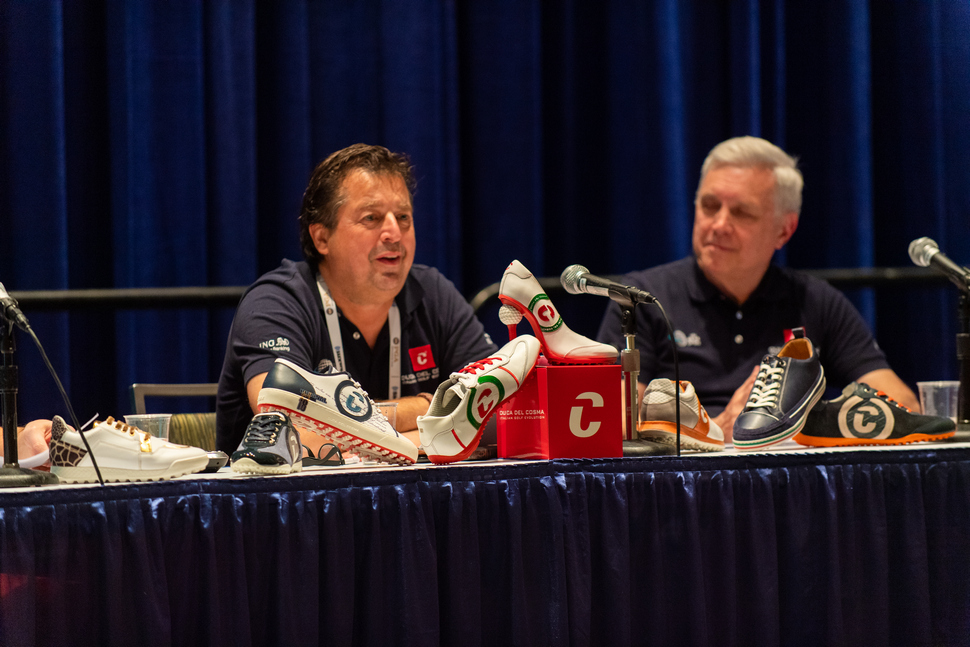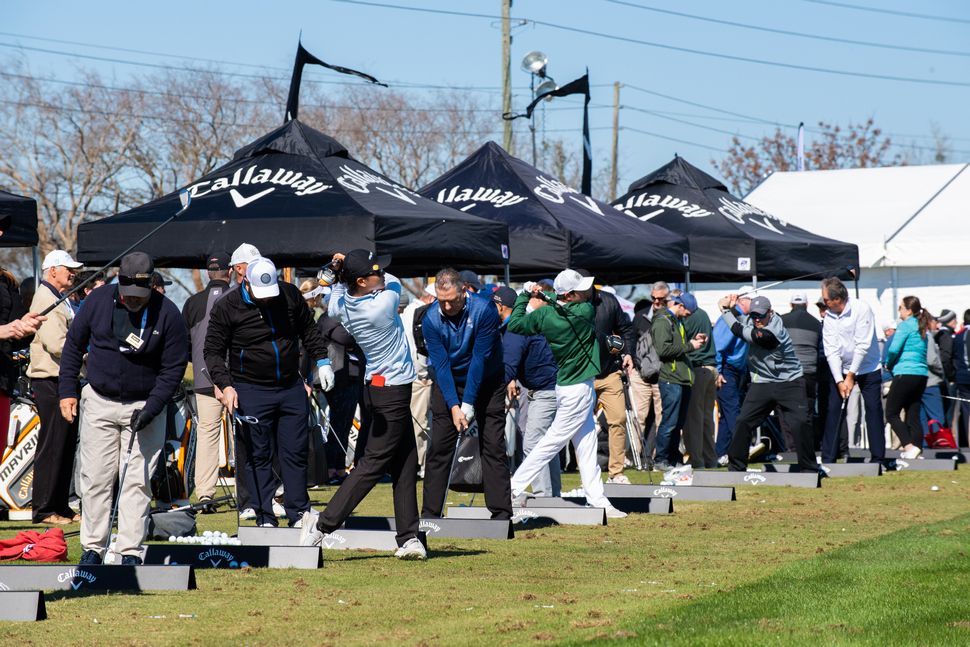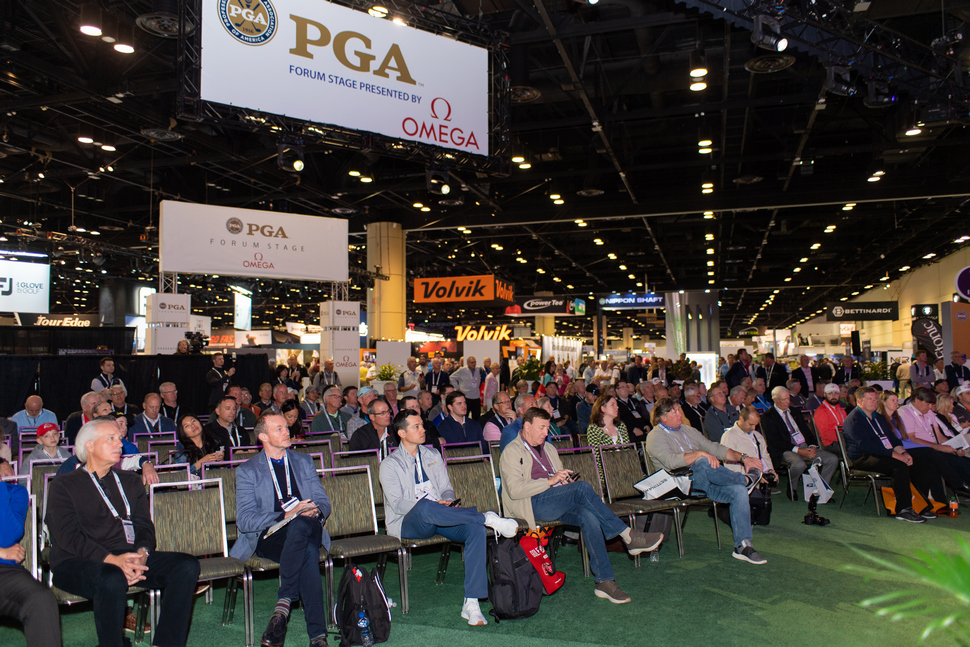ORLANDO, FL. The world of golf only comes together at certain times during the calendar year. The major championships holding forth at the center point for those competing at the highest level in professional golf.
Each January another event — the PGA Show — takes centerstage showcasing the broader business side of the sport. Golf’s mega merchandising event held each year at the Orange County Convention Center includes over 40,000 attendees and provides a clear barometer in gauging the overall mood for the golf season just ahead.
For money to truly talk — enthusiasm needs to be stoked for the golf season ahead.
The 2020 PGA Show escaped the full impact of the raging global pandemic which hit its full stride in March of that year. The ’21 and ’22 shows were only minor events — the former held virtually and the ’22 event plagued by poor weather and a general lack of interest from the main companies within the sport. There were even lingering doubts that the staging of such a grandiose event had run its course — no pun intended.
With two lackluster years now in the rear view mirror the ’23 show is poised to once again feature the customary pageantry highlighting a sport showing a clear rebirth even when the global world was still working through the doldrums.
The golf industry displayed a powerful resiliency even during the darkest of times — providing a major shot in the arm economically in all aspects tied to the business side of golf.
Rounds played spiked considerably upwards. Golf benefited immensely as an outdoor and self-isolating game and permitted play even when the pandemic was raging. Facilities of all types saw a noticeable jump in revenues. Securing memberships became a more challenging proposition with rosters filling up. Waiting lists previously lacking now filled with bulging waiting lists.

Golf equipment sold quickly — people wanting to engage all the modern technology relating to clubs and balls.
New players entered the game – led by an increasing percentage of females. Junior players also saw a surge with girls’ participation rising noticeably.
Yet even with all these positive signs the broader golf industry faces a number of underlying perils. Ones temporarily on hold during the full impact of the pandemic but now mandating attention.
The time factor
The time it takes to play traditional golf has reached a critical mass issue for many. Golf has always been a game of leisure. In years past the wherewithal to set aside large chunks of time was not only doable but sought out.
That’s no longer an automatic assumption.
Traditional golf faces a new reality today as consumers attempt to squeeze in a range of activities into an already cramped 24-hour cycle. Having golf rounds exceed five hours has pushed many avid golfers into searching for alternate forms of the sport that best fit a 2023 daily life schedule.

Related: Golfzon’s Goal – Intersecting improvement and fun
At this year’s PGA Show there will be a number of exhibitors highlighting the increasing popularity of golf simulators. Various companies have come forward in which simulated golf is now combined with a heavy dosage of social interactions where food and drink are also provided.
The explosion of such companies as Topgolf has made a major transformation via driving ranges. As with simulators, the driving range model has been linked to social dimensions allowing avid and non-avid players to play golf without having to face the time crunch associated with the traditional form.
Golf course developers have taken note. In years past — real estate driven projects were promoted through a direct link to an adjoining golf course. With increasing challenges in gaining local and state approvals and to raise sufficient capital to see project through to completion — a number of projects have come forward where less than 18-hole layouts successfully created. In other instances shorter par-3 courses have been added to existing traditional 18-hole layouts. Those playing can golf more quickly and at a fraction of the costs normally incurred.

The $$$ issue
Exhibitors at any PGA Show are quick to display various products. The major equipment companies eager to rollout “new” clubs touting a range of claims that tout “more” and “better” with new generation of various clubs. Singular clubs such as drivers can easily exceed $500 from a number of premium club producers. Even putters have seen prices skyrocketed into the range of several hundred dollars.
The cycle drivers are constantly tweaked. This now done over a far shorter period of time and the net benefit from a previous model to the latest one is a matter of debate in terms of the gains derived.
Golf has never been a game of modest costs. Being able to have a complete set of clubs with a golf bag can easily top $2,000. A dozen premium golf balls can easily go beyond $50 per dozen. The socio-economics of the sport have clearly favored those with the deepest of pockets and remain a key barrier for those wishing to play but have other more pressing daily needs to meet.
Playing traditional golf can mean another added cost in related greens fees. Private membership entails added sums tied to initiation costs and then ongoing expenditures tied to food and beverage, pro shop costs and those tied to other club services.
The golf industry faces an ongoing battle in seeking to drive revenues higher but being ever mindful that expanding the active player profile to a wider array of players will take inventiveness and ongoing efforts.

Can impactful instruction for all happen?
Golf is a challenging game and the need for quality and impactful teaching is a growing concern. New players have a shorter time frame for patience and having limited quality instruction can mean a quick exit from the sport.
Impactful instruction does happen but often times the alignment is with private clubs and those at the resort level. Access to such teachers and the related costs in sustaining such a connection is an ongoing challenge.
There is also the added question in how prepared are those teaching now. While overall technology has meant better clubs and balls — there has been a stagnation in terms of the base handicaps for men and women.
Getting players enthused about playing comes from playing better. Can key stakeholders at the PGA of America go far deeper in connecting to those with limited resources so that they will enjoy the sport and seek to play it more often?
Can technology be tamed? Should it?
Looming in the shadows for golf is a very real possibility the United States Golf Association (USGA) and R&A, the two bodies responsible for the rules of golf — may weigh in on the distances gained from modern golf balls and clubs. The ball debate has raged on for a number of years and the surge in overall distances at the elite level has radically change the nature of the game.
Power golf is now the manner in which the sport is centered. Is that level of increased distance gains healthy for golf. For the two governing bodies that answer is no?
What will USGA / R&A do on regulating more stringently golf balls and clubs?
Bi-furcation of the sport — with rules for those at the elite level and those playing the game recreationally has been ruled out by a number of key stakeholders — including the USGA and R&A — but that matter is no longer a foregone conclusion and may be revisited.
Will a joint announcement from the USGA and R&A happen soon? There’s been speculation an action may happen prior to this year’s Masters. In any event — a reshaping of how technology impacts the game and how the game is played — at all levels — poses a range of possible outcomes and how each is shaped risks outcomes that at the present may not be fully accounted for going forward.
Cutting back the distances attained by modern golf balls is no small task. The stakes high. The long-term consequences move golf into unchartered waters.

Millennials on the march
The pandemic’s intersection with the PGA Show provided a clear demarcation between generations of golfers. Baby boomers have long been the dominant players — supporting the game financially and providing the bulk of active players. Now baby boomers are fading from the top position and while they still command a clear role the time in the spotlight is more and more fading.
Millennials are now the growing force. The impact of the new generation means new involvements at all levels of the sport. That can mean a range of actions and involvements that can reshape how golf moves forward. Mention to golfers 20-25 years ago that players would be playing music while golfing and the likely pushback would have been swift. That’s not the case any longer.
Millennials have a love for golf but the exact shape and form promises possibilities, hard to say with certainty what they will be and how the game will be impacted by such actions.

Will buzz be in the air?
The start of any PGA Show is Demo Day. This is where a range of golf companies descend on Orange County National Golf Club and are able to sample personally the newest additions to the golf market. The gathering at Tuesday’s event was noticeably larger than the ’22 event — helped by better weather.
But spaces were open at Demo Day and the numbers present were far higher than the year prior but less than in previous pre-pandemic times.
The bigger question comes with Wednesday opening day. Will those in attendance demonstrate a contagious upbeat feeling — taking the sport to a far higher level than ever before? The question will need to be answered.
The 2023 PGA Show is clearly beyond the ominous shadow of the pandemic but can the sport of golf reach a new level of momentum?
Golf is spelled with the first two letters — G-O.
The next three days will certainly provide a range of interesting clues. Signifying how fast the sport is ready to proceed, knowing full well the potential land mines that need to be smartly avoided.
That debate is now at hand with this year’s PGA Show.
